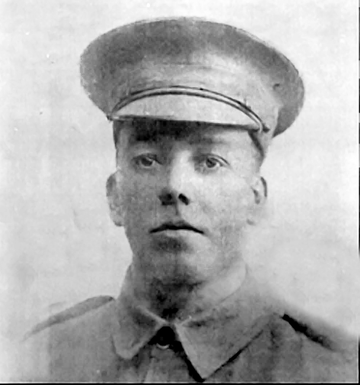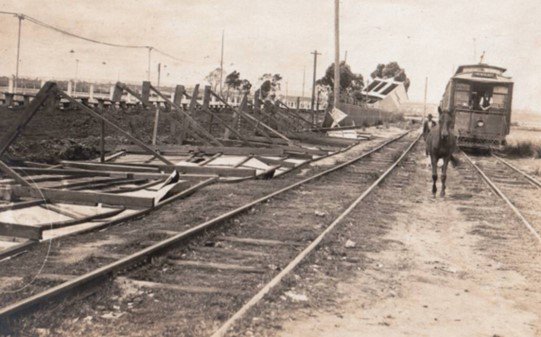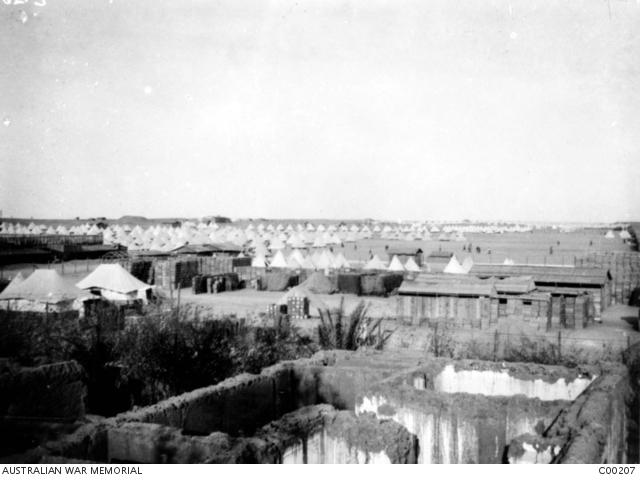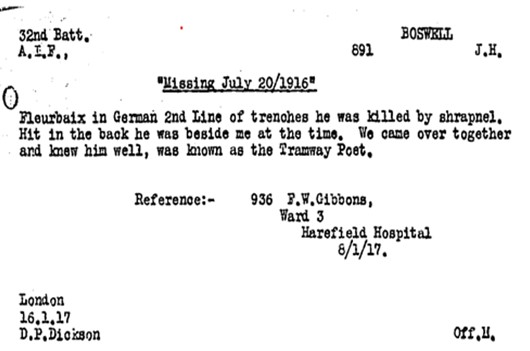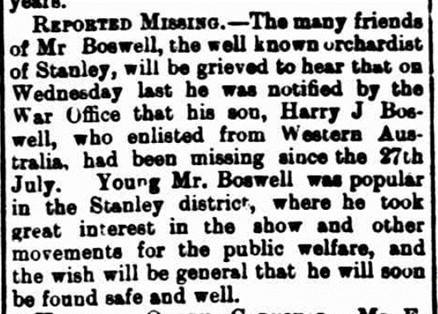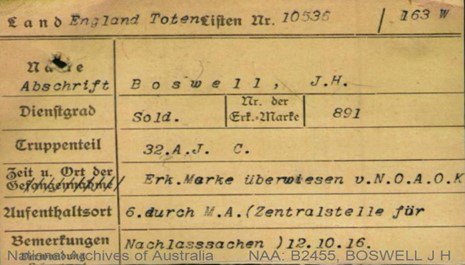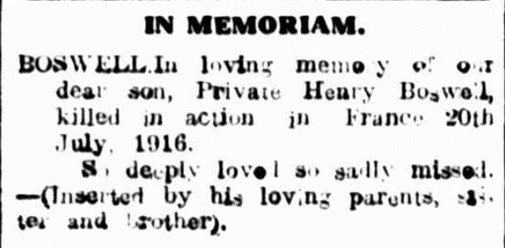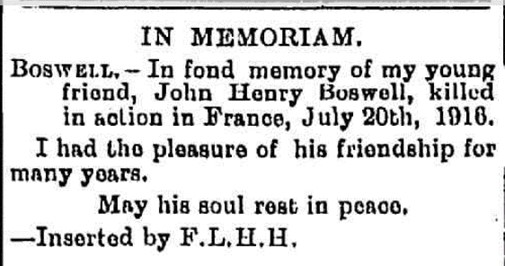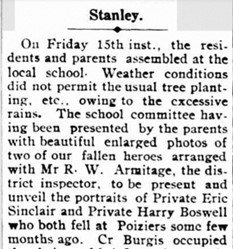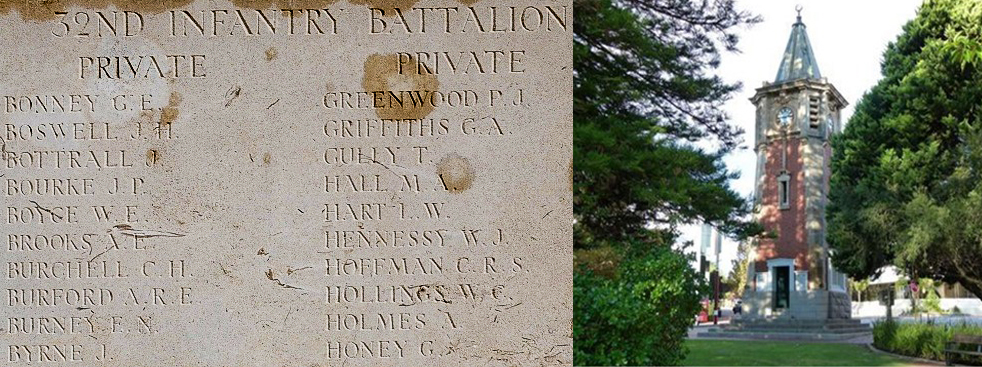John Henry BOSWELL
Eyes brown, Hair brown, Complexion fair
Harry Boswell - The Tramway Poet
Can you help us identify Harry?
John Henry Boswell was Killed in Action at Fromelles. Harry’s body was never found after the battle of Fromelles in 1916 - there is a chance he might be identified, but we need help to find family DNA donors. As he was listed as being buried by the Germans – and in the 32nd battalion, his chance of being identified increases. We are still searching for suitable family DNA donors.
If you know anything of his connections or relatives in Victoria, Australia or elsewhere, we would love to hear from you. He was born in Stanley near Beechworth, Victoria.
If you know anything of contacts here in Australia, please contact the royce@fromelles.info or Unrecovered War Casualties army. UWCA. Phone: 1800 019 090 Email: army.uwc@defence.gov.au..
See the DNA box at the end of the story for what we do know about his family.
From Rural Victoria to Western Australia
John Henry Boswell “Harry” was born on the 16th Aug 1890 in Stanley, Victoria. His father Henry James Boswell was the son of a nurseryman and was employed as a driver at one of the Stanley sawmills, but suffered a broken leg three times in a few months. This left him very lame and he turned his attention to the establishment of an orchard. He mainly grew apples and had a successful business selling in the area.
He was a man with whom it was ever a pleasure to do business and by supplying good apples and potatoes at reasonable prices he worked up a considerable connection in Beechworth where his cheerful presence was always welcome.
He passed away in 1928. Isabel Honorah Enright, Harry’s mother died in 1922. She lost a brother Thomas Enright at Picardie, France in Aug 1916.
They had three children, with Harry the oldest of the three.
- John H (Harry) 1890—1916 Francs
- Myrtle Isabel 1893-1975 married Stephen Edward Weldon
- Stanley James 1893-1975 married Bridget Evelyn Breustedt (5 children)
Harry was a poet and won 2nd prize In South Street competitions in Ballarat, for 'original poem, "Australia— the grandest of the grand". You can read a poem entitiled "The Cricketers" written by Harry in 1911 here.
Like many Victorians struck by the depression in the 1890s, some of the extended Boswell/Enright family made the long journey from Victoria by ship to the Western Australian to join the gold rush. Harry was still living in Stanley in 1913, working as a labourer, but by 1914 he was living with his uncle Alfred Enright at 23 Union St, Subiaco WA.
Alfred and his family, who had moved to WA much earlier and was working for the WA newspaper. Harry’s uncle Thomas was a gold miner in Boulder, Kalgoorlie. Harry found work as a tram conductor in Perth. He must have been an interesting fellow to ride with, as one of his mates in the Army called him “the Tramway Poet”.
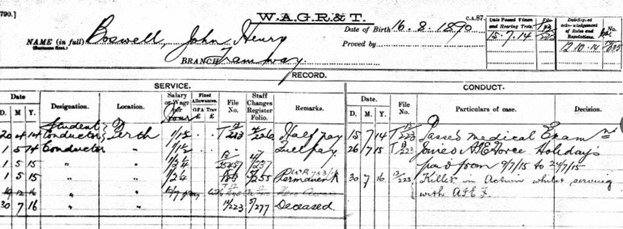
Off to War
Harry enlisted at Blackboy Hill near Perth on 7 July 1915 and was assigned to the 32nd Battalion, C Company. Harry’s 38 year old uncle Thomas also enlisted, but in February 1916 (Service Number 4946) after Harry was in Egypt. Thomas was in the 51st Battalion.
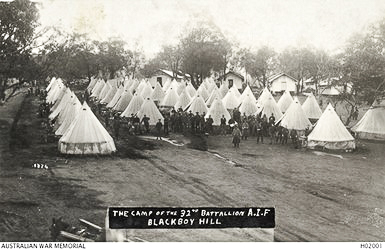
The 32nd Battalion was formed at Mitcham, South Australia on 9 August 1915. A and B Companies were to be from South Australia while C and D from Western Australia. The men from WA arrived in Adelaide at the end of August and training for all continued there until they departed for Egypt on 18 November 1915 on the troop ship HMAT A2 Geelong.
As reported in The Adelaide Register:
“The 32nd Battalion went away with the determination to uphold the newborn prestige of Australian troops, and they were accorded a farewell which reflected the assurance of South Australians that that resolve would be realised.”
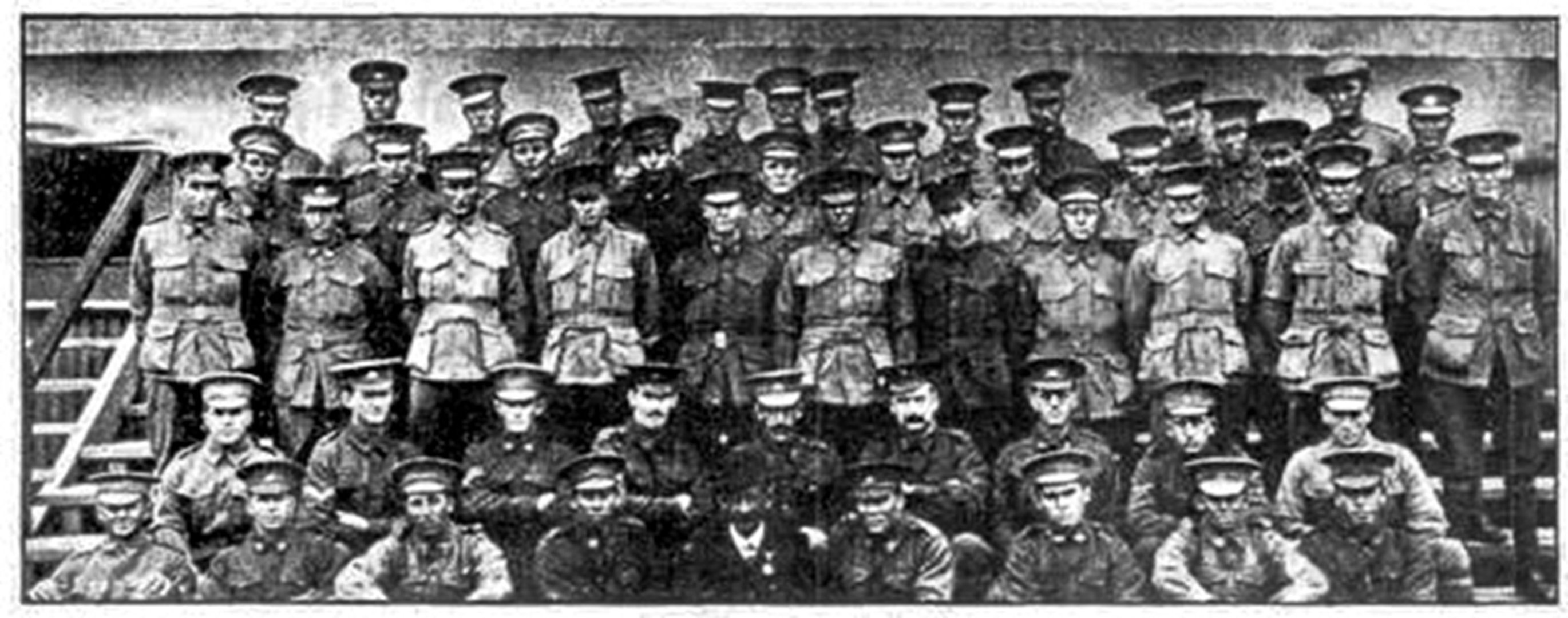
Egypt
Harry arrived in Suez on 14 December 1915 and moved to El Ferdan just before Christmas. A month later they marched to Ismailia, then to Tel El Kabir, where they stayed for February and most of March.
The next stop was at Duntroon Plateau and Ferry Post until the end of May, training and guarding the Suez Canal. Their last posting in Egypt was a few weeks at Moascar. One soldier’s diary complained of being “sick up to the neck of heat and flies”, of the scarcity of water during their long marches through the sand and he described some of the food as “dog biscuits and bully beef”. He did go on to mention good times as well with swims, mail from home, visiting the local sights and the like. Source, Australian War Memorial C2081789 Diary of Theodor Milton PFLAUM 1915-16 ]] You can read the soldier story here for Theodor Pflaum .
To the Western Front
After spending six months in Egypt, the call to support the British Expeditionary Force on the Western Front came in mid-June. They left from Alexandria on the ship Transylvania on 17th June 1916 and arrived at Marseilles, France on 23rd June 1916. After arriving in Marseilles, the 32nd departed by train for the two-day trip to Steenbecque. Their route took them to a station just out of Paris, within sight of the Eiffel Tower, then through Bologne and Calais, with a view of the Channel, and finally headed to St Omer and Hazebrouck, about 30 kilometres from Fleurbaix.
Theodor Pflaum (No. 327) wrote about the trip in his diary:
“The people flocked out all along the line and cheered us as though we had the Kaiser as prisoner on board!!”
Wesley Choat (No. 68), for one, was glad to be out of Egypt, but he was well aware of what laid ahead:
“The change of scenery in La Belle France was like healing ointment to our sunbaked faces and dust filled eyes. It seemed a veritable paradise, and it was hard to realise that in this land of seeming peace and picturesque beauty, one of the most fearful wars of all time was raging in the ruthless and devastating manner of "Hun" frightfulness”.
Training continued with a focus on bayonets and the use of gas masks, assuredly with a greater emphasis given their position near the front.
Battle
The 32nd moved to the front on 14 July and were into the trenches on 16 July for the first time, only three weeks after arriving in France.
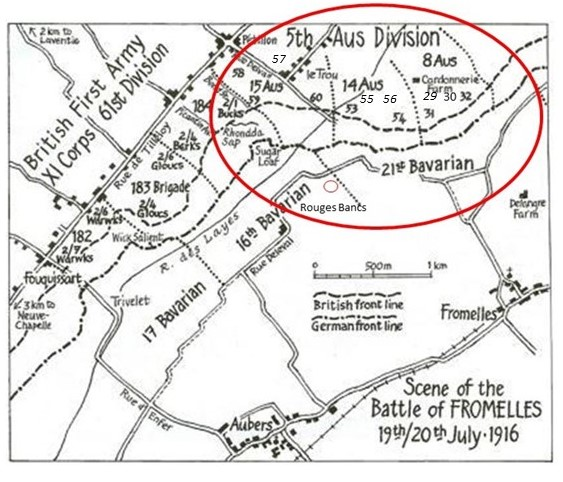
On the 17th they were reconnoitering the trenches and cutting passages through the wires, preparing for an attack, but it was delayed due to the weather. D Company’s Lieutenant Sam Mills’ letters home were optimistic for the coming battle:
“We are not doing much work now, just enough to keep us fit—mostly route marching and helmet drill. We have our gas helmets and steel helmets, so we are prepared for anything. They are both very good, so a man is pretty safe.”
On the morning of the 18th, A and C Companies went back into the trenches to relieve B and D Companies. B and D rejoined on the 19th. All were in position by 5.45 PM and the charge over the parapet began at 5:53 PM. Harry’s C Company and A Company were the first and second waves to go, B & D the third and fourth.
As Harry was in the Machine Gun Section, he would have been carrying a heavy load as well as being a notable target for the snipers. They were successful in the initial assaults and by 6.30 PM were in control of the German’s 1st line system (map Trench B), which was described as:
practically a ditch with from 1 to 2 feet of mud and slush at the bottom
Unfortunately, with the success of their attack, ‘friendly’ artillery fire caused a large number of casualties. They were able to take out a German machine gun in their early advances, but they were being “seriously enfiladed” from their left flank.
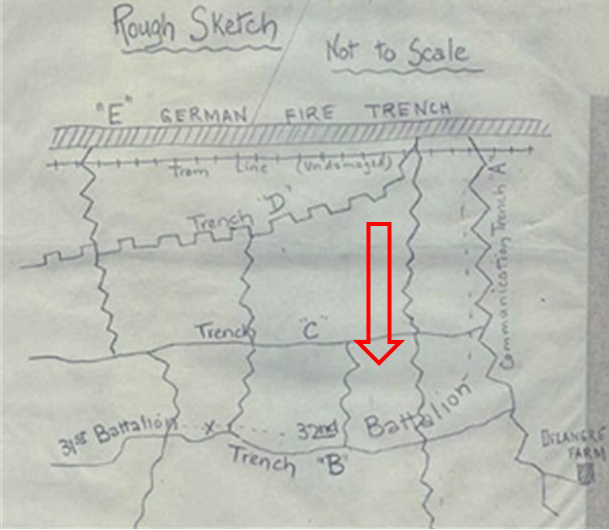
By 8:30 PM their left flank had come under heavy bombardment with high explosives and shrapnel. Return bombardment support was provided and the 32nd was told that “the trenches were to be held at all costs”.
Source AWM4 23/49/12, 32nd Battalion War Diaries, July 1916, page 12
Fighting continued through the night. Up ahead, the Australians made a further charge at the main German line beyond Trench B, but they were low on grenades, there was machine gun fire from behind and from the emplacement at Delangre Farm and they were so far advanced that they were getting shelled by both sides. Harry was in these advances and at some time during the night was hit in the back by shrapnel and killed, as reported by his mate F.W. Gibbons (936), who was beside him at the time.
Frederick William Gibbons, 936, 32nd Battalion, C Company was originally from WA and returned to Australia on the 1 November 1917 after his right leg was amputated following his wounding at the Battle of Fromelles.
At 4:00 AM the Germans began an attack from the Australian’s left flank, bombing and advancing into Trench A (map). Given the Australian advances that had been made earlier, the rear Trench E had been left almost empty, which then enabled the Germans to be in a position to surround the soldiers of the 32nd. At 5:30 AM the Germans attacked from both flanks in force and with bombing parties. Having only a few grenades left, the only resistance the 31st could offer was with rifles.
“The enemy swarmed in and the retirement across No Mans’ Land resembled shambles, the enemy artillery and machine guns doing deadly damage.”
What was left of the 32nd had finally withdrawn by 7.30 AM on the 20th. The initial head count was devastating – 71 killed, 375 wounded and 219 missing. The final impact was that 225 soldiers of the 32nd Battalion were killed or died from wounds sustained at the battle and of this 166 were unidentified. As of 2024, 41 of these soldiers have been identified from the German mass grave at Pheasant Wood found in 2008.
Lieutenant Sam Mills survived the battle. In his letters home, he recalls the bravery of the men:
“They came over the parapet like racehorses……… However, a man could ask nothing better, if he had to go, than to go in a charge like that, and they certainly did their job like heroes."
On the Home Front
Little did Harry’s local Victorian paper know that they published an almost a prophetic article on the day of the battle, 19 July:
The Empire's Cause - OUR ROLL OF HONOR
Right throughout the Commonwealth Australia’s sons have nobly, responded to the call to arms to assist the Empire in the present European straggle. The fact that so may men have been efficiently equipped, trained and sent into the field has called forth the greatest admiration from the British leaders.
This district, in common with other parts of the State, has contributed its quota. The lads are all well known, and we have no hesitation in saying that when the time comes for them to join the firing line they, will not be found lacking in maintaining the best traditions of Australian soldiers and the honor of the district. (Harry is listed on the roll)
Harry was among the initial count of 219 missing soldiers from the 32nd who “upheld the honor of the district” that very day.While it was difficult to work through the casualties and missing from the battle, the Army did wire the family that Harry was missing. Articles about Harry began to appear in the Australian papers from late August.
However, with the huge losses from the battle, any further hard information was nearly impossible to come by. Red Cross interviews, POW information and German communications, etc were slow and the Army was seeking a reasonable degree of proof.
After the initial notification, the first “news” Harry’s mother and father received was a 25 September 1916 letter from his mates about a parcel that Isabel had sent to Harry prior to the battle. Corporal James Parker-Laycock (1026, C Company, 32nd Bn), wrote:
'Madam, I am taking the liberty to write you these few lines on behalf of the boys in my section who have just opened and enjoyed immensely the contents of a parcel that you had sent along to your son whom I am extremely sorry to say got killed in action on 20th July during an engagement we had with the enemy and the Quartermaster has ordered that if any parcels come for our late comrades they are to be divided amongst the mates he had in the old company to which they belonged so that was the reason why we received your son's parcel having known him from some considerable time and a very popular mate he was amongst the boys here he belonged to the Machine Gun Section of our company and during the engagement they lost nearly all their belonging to the M. Guns and myself and mates express their deepest sympathy with you in the loss of your brave son and our comrade in arms.'
“I had a friend of Harry's call here inquiring for him, Pte Sargeant of 29th Batt. He said he came from Stanley, but he was too late to see Harry”
Private William Sargeant (930) was originally from Beechworth, a nearby town. This letter prompted Private Boswell's mother, Isobel, to write to Colonel Hawker at the District Headquarters of the 3rd Military District on 14 November 1916 and state that:
(since) 'Corporal J. Parker-Laycock of same company and Batt saw my son killed in action on that date[,] will you kindly try and find out officially about it?'
After Isabel supplied the original letter to Base Records, their response on 22 January 1917, basically said that J. Parker-Laycock’s advice could only be considered as hearsay and thus may be unreliable, which was a possibility.
In November 1916 a Prisoner of War German list dated 4/11/16 received by The Red Cross Wounded and Missing Enquiry Bureau, Australian Branch, British Red Cross Society on the 24 November 1916, showed that 'identification marks found on the Prisoner of War are inspected by the General War Bureau and shown in the lists as under:- DEAD' The German Death List or GDL is a list of names of soldiers killed in the Battle of Fromelles sent by the German Army through various channels to the British in November 1916. In accordance with the Geneva Convention, German soldiers recorded the details of enemy soldiers killed or captured, afforded the enemy dead appropriate burial and repatriated identity tags and personal effects through the Red Cross.
The German Death List was transmitted from the German Army, through the German Red Cross to the International Red Cross in Geneva, to the British Red Cross in London and on to the Australian Red Cross for liaison with the respective Armies.
A note on his Red Cross file simply states:
“Prisoner of War German list dated 4/11/16 recvd by Wounded and Missing Enquiry Bureau, Australian Branch, British Red Cross Society', 24 November 1916, show that 'identification marks found on the Prisoner of War are inspected by the General War Bureau and shown in the lists as under:- DEAD“
“Identification disc received from Germany', 13 March 1917. 'No particulars afforded except that soldier is deceased. To be reported KILLED IN ACTION, 20/7/16' on the authority of Assistant Adjutant General, ANZAC Section, War Office.”
A formal “in the field enquiry” was held on 11 April 1917 and Harry was confirmed as Killed in Action. His ID disc was sent to the family in late June 1917. If losing a son were not enough, the War was not yet done with Isabel. She also lost her brother Thomas a month later, August 1916, in the battle of Pozieres.
He, like Harry, has no known grave.
Harry was clearly missed by all.
In November 1917, Isabel received an unsolicited, complementary letter from Harry’s superior officer, Lieutenant F. M. Nelson (excerpts below):
“I would like to express my most sincere sympathy in the loss of so fine a lad.”
“You should not grieve for him as he died a noble death.”
“Your son was in my Machine Gun Section, and did splendid work with his gun. At one time when I visited him he was the only one on the gun, the others having been killed or wounded.”
“He died a painless death.”
Harry was awarded the 1914-15 Star, the British War Medal and the Victory Medal.
He is commemorated at:
- Australian War Memorial Roll of Honour,
- Beechworth War Memorial,
- Subiaco Fallen Soldiers Memorial,
- V.C. Corner Australian Cemetery Memorial
- Stanley State School Roll of Honour
Harry Could Still Be Found
The Fromelles Association (contact: royce@fromelles.info or geoffrey@fromelles.info) are currently seeking family of this soldier, with a view to the identification of suitable DNA donors for the sole, specific purpose of identification. We welcome all contact in this regard.
We also urge any family members to contact and register with the Australian Army (contact: army.uwc@defence.gov.au or phone 1800 019 090)
Even more than 100 years after the battle, soldier identification efforts are still going on.
In 2008, a German grave was discovered that contained the remains of 250 soldiers from the battle. As of 2024, DNA testing from relatives that have been able to be located has been successful for the identification of 180 of the bodies in the grave. 41 of these identified soldiers were from the 32nd Battalion
Harry may be one of the yet unidentified soldiers. Please come contact the Fromelles Association if you know of any family connections for possible DNA donors.
DNA samples are being sought for family connections to
| Soldier | John Henry Boswell (1890 – 1916) |
| Parents | Henry James Boswell (1860-1928) b Mt Eliza, Victoria and Isabel Honora Enright (1867-1920) b Hobart Tasmania, d Beechworth Victoria |
| Siblings | Myrtle Isabel (1891 -1975) married Stephen Edwin Weldon | ||
| Stanley James (1893 -1975) married Bridget Evelyn Breustedt |
| Grandparents | |||
| Paternal | Henry George Boswell (1836-1901) b Mt. Eliza, Victoria, d Melbourne, Victoria and Jane West (1837-1925) b Northamptonshire England d Camberwell, Victoria | ||
| Maternal | John William Enright (1844-1918) b Old Beach Tasmania , died Stanley Victoria and Caroline Smith (1845-1884), born Launceston, Tasmania died Walhalla Victoria |
Seeking DNA Donors

Contacts
(Contact: royce@fromelles.info or geoffrey@fromelles.info).
(Contact: army.uwc@defence.gov.au or phone 1800 019 090).
Donations
If you are able, please contribute to the upkeep of this resource.
(Contact: bill@fromelles.info ).
